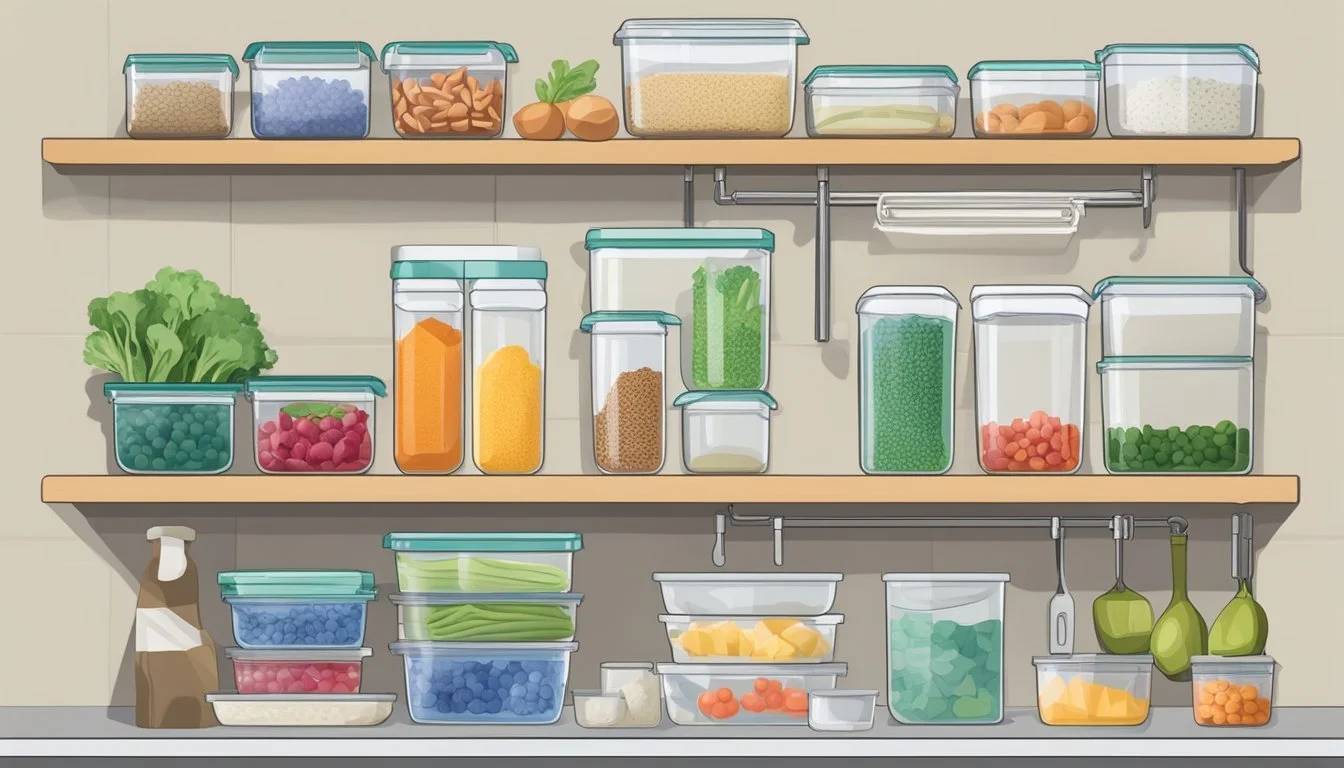The Ultimate Guide to Organizing Your Kitchen for a Low-Oxalate Diet
Streamlined Strategies for Healthful Living
Adhering to a low-oxalate diet requires careful kitchen organization to minimize the intake of oxalates, compounds found in many foods that can contribute to health issues such as kidney stones. Organizing the kitchen by categorizing foods based on their oxalate content is critical for those who need to keep their dietary oxalate levels in check. This approach not only simplifies meal preparation but also helps individuals avoid high-oxalate ingredients that might otherwise sneak into their meals.
Understanding which foods are low in oxalates is the first step in setting up a kitchen conducive to this diet. Fresh fruits such as mandarin oranges, specific vegetables, dairy products like low-fat yogurt, and whole wheat options present a variety of ingredients for creating nutritious and safe meals. Meanwhile, thoughtful food storage and clear labeling can prevent cross-contamination and accidental consumption of high-oxalate foods.
By focusing on the layout of the kitchen space, individuals can place low-oxalate foods at the forefront, making it easier to reach for the right ingredients. This organization extends to cooking tools and appliances, which should be readily accessible to encourage the preparation of low-oxalate recipes. With these strategic adjustments, individuals following a low-oxalate diet can efficiently prepare meals without the stress of navigating through unsuitable food options.
Understanding Oxalates and Low-Oxalate Diets
In this guide, we explore the nature of oxalates, the reasons behind adhering to a low-oxalate diet, and methods for identifying foods with high oxalate content.
What Are Oxalates?
Oxalates are organic compounds found in a wide range of foods. They can bind to minerals to form compounds, such as calcium oxalate, which may contribute to the development of kidney stones when present in high concentrations in the urine. Although oxalates are naturally present in the body, excessive consumption can increase urinary oxalate levels, posing a risk for stone formation in susceptible individuals.
Benefits of a Low-Oxalate Diet
A low-oxalate diet aims to reduce the intake of oxalates to help decrease the risk of kidney stone formation. This diet is particularly beneficial for those with a history of calcium oxalate stones or individuals with high urinary oxalate levels. By limiting the consumption of high-oxalate foods, one can potentially lower the risk and frequency of stone formation and promote better urinary and kidney health.
Identifying High-Oxalate Foods
High-oxalate foods contain more than 10 milligrams of oxalates per serving, and it is crucial to recognize and manage their consumption. Common high-oxalate items include certain fruits, vegetables, nuts, seeds, and starches. Conversely, low-oxalate foods generally contain less than 2 milligrams per serving, and incorporating these into your diet can aid in maintaining lower urinary oxalate levels. When organizing a kitchen for a low-oxalate diet, one must be informed about the nutrition content of their food choices.
Essential Nutrients and Low-Oxalate Eating
When adhering to a low-oxalate diet, one must carefully balance essential nutrients to avoid deficiencies while managing oxalate intake.
Calcium and Oxalate Relationship
Calcium plays a critical role in a low-oxalate diet as it binds with oxalate in the intestines, reducing oxalate absorption and subsequent urinary levels. Nutrition experts suggest including calcium-rich foods with each meal to optimize this interaction. For optimal absorption, individuals should aim for three servings of high-calcium foods daily. Foods such as milk, yogurt, and cheese are beneficial in this regard.
The Role of Vitamins and Minerals
A well-structured low-oxalate diet should still include a variety of vitamins and minerals. One must monitor the intake of nutrients like iron, magnesium, and potassium, which are essential for overall health. Individuals should consume iron-rich vegetables like kale and broccoli**,** while keeping in mind their oxalate content. Magnesium and potassium can be found in low-oxalate choices such as bananas and avocados. However, care should be taken with vitamin C supplements as they can be converted into oxalates in the body.
Protein Intake on a Low-Oxalate Diet
Protein is vital for bodily functions, but certain sources can be high in oxalates. Those following a low-oxalate diet should opt for lean protein sources, such as chicken, turkey, and fish. Plant-based proteins, often derived from legumes, can be high in oxalates; thus, it's wise to consult a registered dietitian to find suitable alternatives. Adequate hydration is also important to dilute urinary oxalate when consuming protein-rich foods.
Planning Your Low-Oxalate Kitchen
When tailoring a kitchen to accommodate a low-oxalate diet, it's crucial to ensure that staples are in line with dietary needs, food labels are well understood, and meal plans are thoughtfully prepared to avoid high-oxalate foods.
Stocking Low-Oxalate Staples
To maintain a low-oxalate kitchen, one should focus on low oxalate foods such as certain grains, beans, and nuts. Here is a list of items to keep on hand:
Grains and starches: Choose rice, oats, and rye as they are generally lower in oxalates.
Beans: Opt for garbanzo, lentils, and red beans for protein sources.
Nuts: Stock up on flaxseed, pumpkin seeds, and pecans in moderation.
Calcium-rich foods: Incorporate low-oxalate, calcium-rich foods like calcium-fortified beverages to help reduce oxalate absorption.
Understanding Food Labels
It's imperative to read food labels carefully to monitor the presence of high-oxalate ingredients. Pay attention to:
Leafy greens: Many are high in oxalates, so looking for terms like "spinach" or "Swiss chard" is essential.
Additives: Some food additives may contribute to higher oxalate levels.
Nutritional Information: Check for mentions of oxalate content when available, although this is rare.
Creating a Low-Oxalate Meal Plan
A low-oxalate meal plan should incorporate a variety of safe foods while ensuring balanced nutrition. Here’s how to plan:
Breakfast: Include low-oxalate grains like oats and pair with calcium-rich milk or yogurt.
Lunch and Dinner: Focus on meals with rice or quinoa as a base, add in low-oxalate vegetables like broccoli or cauliflower, and a portion of lean protein.
Snacks: Consider cheese sticks, apple slices, or homemade popcorn, which are lower in oxalates.
A low-oxalate diet should consider not only oxalate content but also the pairing of foods to enhance the absorption of nutrients and minimize oxalate buildup.
Low-Oxalate Recipes and Cooking Tips
Maintain a low-oxalate diet by focusing on the right balance of fruits, vegetables, proteins, and starches. This section provides specific recipes and culinary approaches to help ensure your kitchen supports your dietary needs.
Preparing Vegetables and Fruits
When incorporating vegetables and fruits into your low-oxalate diet, it is vital to be selective. For salads, replace high-oxalate greens like spinach with arugula, which is a nutritious and safer option. Sautéed red onions and mushrooms can enrich dishes with flavor and nutrients while keeping oxalate levels in check. Opt for apples and cranberries in fruit salads or as snack options rather than higher oxalate fruits.
Suggested Low-Oxalate Vegetable and Fruit Inclusions:
Arugula Salad
Kale Salad with Apple and Cranberries
Sautéed Mushrooms and Red Onions
Low-Oxalate Proteins and Alternatives
Proteins are a cornerstone of any diet, and choosing low-oxalate options is straightforward. Lean meats such as pork loin and ground beef are excellent choices. When preparing a dish like Egg Roll in a Bowl or Tacos, consider using these meats. Remember to use lettuce leaves as taco shells to minimize oxalate content. For vegetarian options, cheese such as cheddar can be used, but in moderation due to its oxalate content.
Protein Selection Guidelines:
Pork Loin with Balsamic Sauce
Ground Beef for Lettuce-Wrapped Tacos
Moderate Use of Cheddar Cheese
Safe Grains and Starches for Your Diet
Including grains and starches in a low-oxalate diet requires careful selection. White rice and pasta made from low-oxalate grains can serve as the foundation for many meals. Breakfast options like Blueberry Baked Oatmeal utilize grains that are typically lower in oxalates. Always check the type of grain or starch and opt for those with minimal oxalate content.
Approved Low-Oxalate Grains and Starches:
White Rice
Low-Oxalate Grain Pasta
Blueberry Baked Oatmeal with Approved Grains
Managing Dietary Restrictions in Social Settings
When adhering to a low-oxalate diet, social situations involving food require careful navigation to maintain one's health and dietary compliance. Effective communication of one's dietary needs and proactive planning are essential, especially when dining out or attending social gatherings to avoid nutrient deficiencies and ensure a variety of safe food options are available.
Dining Out on a Low-Oxalate Diet
When dining at restaurants, individuals should select establishments that offer detailed ingredient information and are willing to accommodate special dietary requirements. It's beneficial to:
Review menus online prior to visiting to identify potential low-oxalate options.
Contact the restaurant in advance to discuss the low-oxalate diet with the chef or manager.
Choose dishes with ingredients known to be low in oxalates, such as rice or lean meats.
A healthcare professional can provide guidance on making safer food choices when restaurant menus are not explicit about their dishes' oxalate content.
Navigating Social Gatherings
Social events often revolve around food, which can be a challenge for those on a low-oxalate diet. To manage dietary restrictions in social settings:
Inform the host of your dietary needs well in advance.
Offer to bring a low-oxalate dish that everyone can enjoy.
Focus on permissible foods such as certain fruits, vegetables, and dairy products that are known to be lower in oxalates.
By doing so, individuals can actively participate in the social aspect of the gathering without feeling excluded or risking their health.
Communicating Your Dietary Needs
Clearly communicating dietary restrictions is key in any social situation. This involves:
Being upfront about your dietary limitations with friends, family, and service staff.
Carrying a card or digital note listing your dietary restrictions to show when ordering or discussing food options.
Educating interested parties about what a low-oxalate diet entails and why it's important for your health.
Proper communication helps to prevent misunderstandings and ensures that one can manage their diet confidently in social settings.
Maintaining Overall Health While Managing Oxalate Intake
Adopting a low-oxalate diet requires careful planning to ensure overall health and well-being are not compromised. When organizing a kitchen around this dietary need, individuals must pay attention to hydration, nutrient balance, and engage with healthcare professionals to tailor their diet appropriately.
Hydration and Low-Oxalate Diets
Hydration is paramount on a low-oxalate diet as it aids in the prevention of kidney stones. Individuals should aim for a fluid intake of about 2-3 liters per day, ensuring that water is the primary beverage choice. Beverages low in oxalates, such as water, can help in diluting the concentration of oxalate in the urine, thus reducing the risk of stone formation.
Balancing Nutrients While Lowering Oxalates
A low-oxalate diet should not lead to nutritional deficiencies. It's essential to incorporate a variety of foods that are low in oxalates but high in other nutrients. One must ensure the following are included:
Calcium-rich foods: Pair oxalate-containing foods with calcium sources to help reduce absorption.
Example: Add milk to a serving of oatmeal.
Iron and Vitamin B6: Monitor for sufficient intake to prevent deficits.
Example: Include servings of lean meats and fish.
Careful attention to dietary guidelines ensures that while lowering oxalates, one still receives the diverse health benefits of a well-rounded diet.
Consulting Healthcare Professionals
Dietary changes, especially those involving dietary restrictions, should be overseen by a healthcare provider to tailor to personal health needs. Regular consultations can guide one on trying low oxalates without compromising their nutritional needs, helping maintain a balance between managing oxalate intake and ensuring overall dietary health.
Supplements and Low-Oxalate Diets
When adopting a low-oxalate diet, it is essential to maintain balanced nutrient intake and consider the role of supplements. Careful management can prevent nutrient deficiencies and promote overall health.
Appropriate Use of Supplements
For individuals on a low-oxalate diet, calcium plays a critical role in reducing oxalate absorption in the intestines. They should aim for 1,000-1,200mg of calcium per day, which can sometimes necessitate supplementation, especially if dietary intake is insufficient. The timing of calcium supplements is crucial; they should be taken with meals to effectively bind dietary oxalate.
Avoiding Nutrient Deficiencies
A diet low in oxalates may limit the intake of certain foods rich in nutrients like magnesium, potassium, iron, and vitamin C. Selecting alternatives and incorporating specific supplements can help avoid deficiencies. For instance:
Fiber consumption may decrease with lower intake of certain fruits and vegetables, so a fiber supplement can be beneficial.
Magnesium and potassium supplements can be considered if their levels are low, due to restricted consumption of nuts, certain fruits, and vegetables.
Iron supplementation should be approached with caution, as excess iron can increase oxalate production. A healthcare professional can provide personalized advice.
Working With a Registered Dietitian
Consulting a registered dietitian is highly recommended to tailor a supplement plan that complements a low-oxalate diet. A dietitian can assess individual needs and monitor nutrient levels to ensure that dietary changes do not lead to unintended consequences. They will also interpret lab results, like urine oxalate levels, to adjust the diet and supplementation regimen for optimal kidney health.
Living with Special Conditions
When an individual's dietary requirements must accommodate specific health conditions, such as kidney stones or hyperoxaluria, organization and planning become crucial. Special dietary adjustments and strategic kitchen organization can lead to better management of their condition and improvement in urinary health.
Adjusting the Diet for Kidney Stones
Individuals prone to calcium oxalate kidney stones should modify their diet to reduce oxalate intake. A low-oxalate diet includes avoiding foods like spinach, rhubarb, and nuts. Instead, their kitchens should be stocked with low-oxalate choices such as cauliflower, bananas, and dairy products low in fat, which help in reducing the urinary oxalate level.
Hyperoxaluria and Diet
Hyperoxaluria, a condition characterized by an excessive urinary excretion of oxalate, can be primary or secondary. Individuals with primary hyperoxaluria, a rare inherited disorder, require strict dietary adjustments. They should prioritize a kitchen environment that supports a low-oxalate diet along with calcium-rich meals to bind oxalate in the gut, as this reduces its absorption and the subsequent oxalate load on the kidneys.
Incorporating Low-Oxalate Strategies Long-term
To maintain urinary health, those affected by oxalate-related conditions need to imbibe low-oxalate dietary practices into their everyday routines. Their kitchen should be laid out with clearly labeled sections for low-oxalate foods and cooking tools that aid in the preparation of these meals. [Reusable labels] and [see-through containers] can facilitate easy access and identification, ensuring that dietary guidelines are followed consistently and accurately.
Beyond the Diet: Lifestyle Considerations
Adhering to a low-oxalate diet is more than just about managing food intake; it encompasses an entire lifestyle approach to support overall health and well-being. Key aspects such as exercise, stress management, and a robust support system play pivotal roles in oxalate management.
Exercise and Oxalate Management
Regular physical activity is crucial in maintaining a healthy lifestyle and can also influence oxalate levels in the body. Engaging in moderate exercise helps to reduce the concentration of calcium and oxalate in the urine, which in turn can decrease the risk of kidney stone formation. Individuals should aim for at least 150 minutes of moderate exercise each week, integrating activities such as swimming, cycling, or brisk walking.
Stress Management and Oxalate Intake
Stress can indirectly affect oxalate levels by prompting unhealthy eating habits that include high-oxalate foods. Effective stress management techniques such as meditation, yoga, and mindful breathing can help individuals maintain a low-oxalate diet by reducing the tendency to seek comfort in foods that might contribute to oxalate accumulation. Regular practice of these activities aids in keeping one's eating habits aligned with dietary guidelines for oxalate management.
Building a Support System
A strong support system is essential for individuals following a low-oxalate diet, especially when faced with social situations that may offer limited dietary options. A support system can include:
Family members who understand the dietary restrictions and help prepare suitable meals.
Friends who accommodate dietary needs during social gatherings or eating out.
Healthcare providers, including dietitians who can offer professional guidance and personalized advice.
Creating an environment of support helps individuals navigate the complexities of diet management and reinforces positive lifestyle changes that contribute to well-being.
Resources and Further Reading
The right resources can guide individuals through the nuances of a low-oxalate diet, from selecting ingredients to preparing meals. Notable cookbooks, educational materials, and community platforms can offer substantial support and information for those looking to organize their kitchen around this dietary need.
Recommended Low-Oxalate Cookbooks
"The Low-Oxalate Anti-Inflammatory Cookbook": This cookbook provides recipes that are low in oxalates, carefully crafted to reduce inflammation and support kidney health.
"Eating Low-Oxalate": A resource filled with kitchen-tested recipes, offering a diverse range of dishes that cater to those monitoring oxalate intake.
Educational Material on Oxalates
Harvard University's Low-Oxalate List: A comprehensive list detailing various foods and their oxalate levels, allowing individuals to make informed dietary choices.
University of Chicago's Kidney Stone Guide: They offer extensive materials on oxalate management, ideal for patients and healthcare professionals.
Connecting with Low-Oxalate Communities
Low-Oxalate Diet Support Group on Social Media: Online platforms where members can share experiences, recipes, and tips for managing a low-oxalate diet.
Consultation with a Registered Dietitian: For personalized guidance, individuals should consider connecting with a registered dietitian specializing in kidney health and low-oxalate diets.












